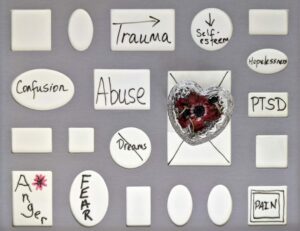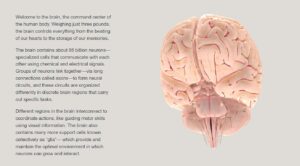The Trauma Response
A sexual assault often involves both physical and emotional pain. Psychologically and neurologically speaking, it is one of the most damaging events that can happen to someone. In the brain, sexual assault is perceived as a threat to survival, in the same way an attempted murder would be processed. We call this a trauma response. It impacts emotion, behavior, memory, and cognition, and these effects last far beyond the event itself.

Hormonal Activity
Trauma results in a heightened response of the hypothalamus and pituitary gland. These parts of the brain communicate with other parts of the brain and body. The hypothalamus tells the pituitary gland that there is a threat, and the pituitary gland signals this to the adrenal glands. The brain and body are flooded with hormones in a state of high arousal. Four main hormones are secreted by the adrenal glands. Catecholamines (such as adrenaline) and cortisol are the excitatory chemicals that put us into ‘survival mode.’ Opiates and oxytocin are the ‘feel-good’ chemicals that regulate the experience emotional and physical pain.
The amygdala is the part of the brain that responds first to fear-inducing or emotionally charged events. The hippocampus processes sensory information and organizes it into memories. These structures, however, are very sensitive to hormonal fluctuation. Some hormones make it easier to interpret and encode sensory information, and some make it more difficult. The hormones that respond to and protect us from threats — catecholamines, cortisol, opiates, and oxytocin — are the very ones that impair memory formation. This is why some people have trouble remembering their trauma.
Hormones have a few other effects on the brain and behavior. The catecholamines and cortisol inhibit the areas of the brain that control reasoning and logic. Temporary damage is done to these neural pathways. During a trauma, one is unable to make rational decisions, because these parts of the brain may not be fully functioning at the time. An individual may default to reflexes or habits they have learned. These reflexive responses are the result of socialization and might appear as politeness, submission, or dissociation — and should not be confused with consent.

Hormonal activity may result in a ‘freeze’ response. The body virtually shuts down. This is called tonic immobility, sometimes referred to as ‘rape-induced paralysis.’ Another form is called collapsed immobility. In these states, one is incapable of fighting back, escaping, or even moving, even if they wanted to.
Finally, the opiate morphine may also make an individual’s emotional response after trauma very blunt; they may seem to have no emotional reaction. This doesn’t mean they weren’t traumatized; they are simply in shock.
Lasting Impacts
Sexual assault can have impacts long after the event occurs. Many people experience complex emotional, behavioral, and even physical changes. These can appear as anxiety, anger, hypervigilance, withdrawl, and changes in eating or in sleep, among many other issues. Due to the culture of victim-blaming, it’s common for a survivor to feel guilty or shameful. These are all normal reactions and look different from person to person.
Some people who have been sexually assaulted develop post-traumatic stress disorder. Even after the traumatic event ends, the brain and body stay in survival mode. While there is no one uniform experience of PTSD, common symptoms include re-experiencing the trauma (such as in flashbacks or nightmares), avoidance behaviors (such as isolating or numbing with substances), being overly alert or reactive (such as feeling jumpy, having panic attacks, or difficulty sleeping), and changes in mood (such as guilt or shame, depression, anger, or trust issues). These symptoms may not occur immediately after the trauma; there can be a delay of weeks or months. PTSD can negatively impact one’s social relationships, performance at work or school, and physical health.

Survival Mode
Simply put, during a sexual assault, the body goes into survival mode. Our brains want us to avoid danger, keep us safe, and lessen the pain we feel. These protective measures affect how we remember traumatic events and make us less rational. They have significant effects on our behavior, many of which are misunderstood. It’s important to remember that everyone’s physical and psychological response to trauma is different and these are automatic responses that we cannot control.
These processes are hardwired into our brains to help us survive. They once helped our ancestors live through danger, but the reality of sexual assault is a lot more complicated than a prehistoric attack from a predator. Social dynamics, cultural attitudes, personal relationships, and infinite nuances about our modern life impact how we understand sexual assault, be it our own or someone else’s. Victim-blaming is in part the result of not knowing how trauma responses look. For those who work with survivors, better understanding how sexual assault impacts the brain and body allows us to provide better care. For everyone, it empowers us to reduce the stigma surrounding sexual assault, but most importantly, to believe survivors.
Learn More About The Brain And How It Works

This interactive brain model is powered by the Wellcome Trust and developed by Matt Wimsatt and Jack Simpson; reviewed by John Morrison, Patrick Hof, and Edward Lein.
Structure descriptions were written by Levi Gadye and Alexis Wnuk and Jane Roskams.
References
Campbell, R. (2012, December 1). The Neurobiology of Sexual Assault: Implications for Law Enforcement, Prosecution, and Victim Advocacy [Interview]. Research for the Real World; National Institute of Justice. https://nij.ojp.gov/media/video/24056#transcript–0
Hopper, J. (2021, February 12). “Reflexes and Habits” Is Much Better Than “Fight or Flight”. https://jimhopper.com/pdf/hopper_2021_reflexes_and_habits.pdf
PTSD UK. Symptoms of Post Traumatic Stress Disorder & C-PTSD. (n.d.). https://www.ptsduk.org/what-is-ptsd/symptoms-of-ptsd/

